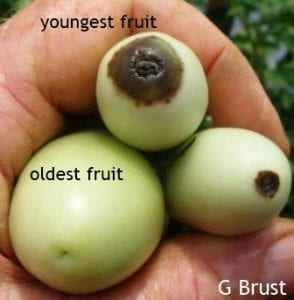Jerry Brust, IPM Vegetable Specialist, University of Maryland; jbrust@umd.edu
The extreme heat that just recently ended was exceptionally stressful on plants, especially newly transplanted plants. But even well established plants found in high tunnels or that were planted early in the year were stressed. Tomato plants in a high tunnel I visited had severe blossom end rot problems that are just now becoming apparent. Usually with blossom end rot you get a few tomato fruit that are all of one general size scattered about on plants. This shows that calcium uptake was deficient just as the fruit was developing. Tomato fruit that reaches the size of a dime usually has all the calcium it is going to need and if it does not the cells of the fruit furthest from the stem do not develop normally and collapse as the cells and fruit expands causing blossom end rot. Calcium (Ca) moves to the plant via mass flow, i.e., where dissolved minerals like calcium move to the root in soil water that is flowing towards the roots. If anything interrupts this constant flow calcium deficiency can occur in developing fruit. For different sized fruit to develop blossom end rot there must have been an extended disruption in calcium uptake. This can be seen in figure 1 where several different size fruit all have developed blossom end rot. Figure 2 shows that large fruit on this particular plant developed before there was a Ca interruption, but the fruit a little younger suffered the hot weather induced Ca interruption, with the smallest, youngest fruit suffering the greatest damage. Tissue analysis from this same set of plants showed that calcium was in the high range when the blossom end rot took place, demonstrating the importance of irrigation and water supply to reduce blossom end rot.
Fig. 1 Several fruit of different sizes with blossom end rot
Fig. 2 Older, larger fruit received enough Ca, but younger, smaller fruit did not


